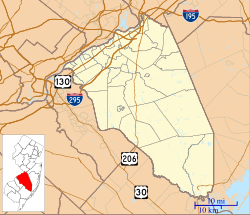Marlton, New Jersey | |
|---|---|
 Thomas Hollinshead House | |
 Location of Marlton in Burlington County highlighted in yellow (left). Inset map: Location of Ocean County in New Jersey highlighted in black (right). | |
 Census Bureau map of Marlton, New Jersey | |
Location in Burlington County Location in New Jersey | |
| Coordinates: 39°54′07″N74°55′45″W / 39.901885°N 74.929277°W | |
| Country | |
| State | |
| County | Burlington |
| Township | Evesham |
| Founded | 1676 |
| Area | |
• Total | 3.31 sq mi (8.57 km2) |
| • Land | 3.30 sq mi (8.55 km2) |
| • Water | 0.0077 sq mi (0.02 km2) 0.25% |
| Elevation | 95 ft (29 m) |
| Population | |
• Total | 10,594 |
| • Density | 3,210.3/sq mi (1,239.52/km2) |
| Time zone | UTC−05:00 (Eastern (EST)) |
| • Summer (DST) | UTC−04:00 (Eastern (EDT)) |
| ZIP Code | 08053 [4] |
| Area code | 856 exchanges: 396, 424, 489, 596, 751, 797, 810, 874, 983, 985, 988 [5] |
| FIPS code | 34-44100 [6] [7] [8] |
| GNIS feature ID | 02390126 [6] [9] |
Marlton is a census-designated place [10] (CDP) located within Evesham Township in Burlington County, in the U.S. state of New Jersey. [11] [12] [13] As of the 2020 United States census, the CDP had a population of 10,594 residents, [3] reflecting a 4.5% increase from the 10,133 enumerated at the 2010 U.S. census, [14] in turn a 1.2% decrease from the 10,260 counted in the 2000 census. [15]
Contents
- History
- Landmarks
- Geography
- Demographics
- 2010 census
- 2000 census
- Transportation
- Education
- Notable people
- References
- Further reading
While Marlton comprises only a small part of Evesham Township, many people colloquially refer to the entire township as Marlton. [16]



